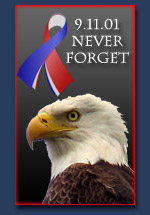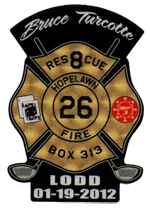 
NOTICE
Requests for OPRA documents, fire investigation reports, or other records should be made by e-mail to the Fire Official at bfp9wertz@comcast.net
Staff
The Bureau of Fire Prevention staff includes both full time and part time employees who provide the various services:
Fire Official: Stew Schmalenberger
Fire Inspector: Mary Wertz
Fire Inspector: Kevin Wertz
Contact the Bureau of Fire Prevention
You can reach the Bureau of Fire Prevention at the following numbers or via e-mail:
Phone: (732) 283-0781
Fax: (732) 283-4378
e-mail: bfp9wertz@comcast.net
You can contact the Bureau via mail at the following address:
Bureau of Fire Prevention
Fire District #9
1222 Green Street
Iselin, NJ 08830
As part of their mission to prevent fires and provide education about fire safety, the Bureau of Fire Prevention provides a number of services and activities, including:
Education and Outreach
The Bureau of Fire Prevention works hard to educate the community concerning fire safety. The Bureau takes advantage of several opportunities to reach out to the community each year. Some of the outreach efforts include:
Community Day at Woodbridge Center Mall

This annual event held at Woodbridge Center Mall provides us the opportunity to discuss fire safety with both adults and children. This popular events includes the distribution of fire safety information to adults, and fire safety themed give aways for the children.
Fire Drills
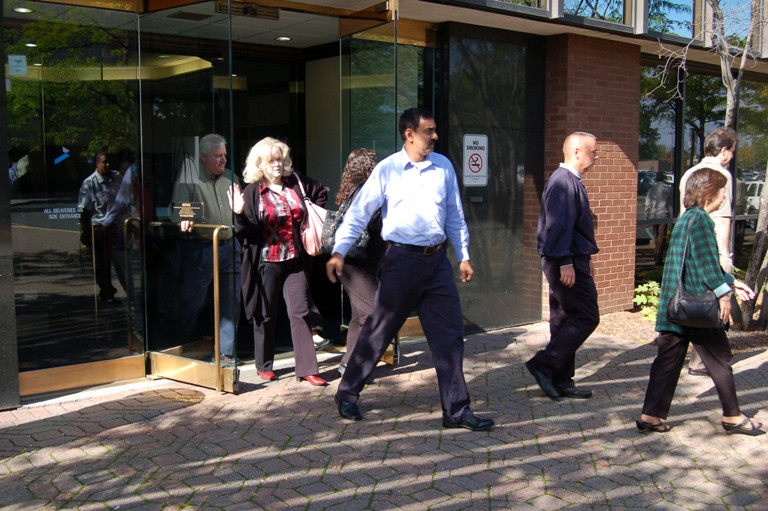
The Bureau of Fire Prevention periodically observes fire drills at local businesses, schools, and day care centers to ensure everyone knows how to quickly and safely evacuate the building in the event of a fire alarm.
Visits to Schools and Day Care Centers
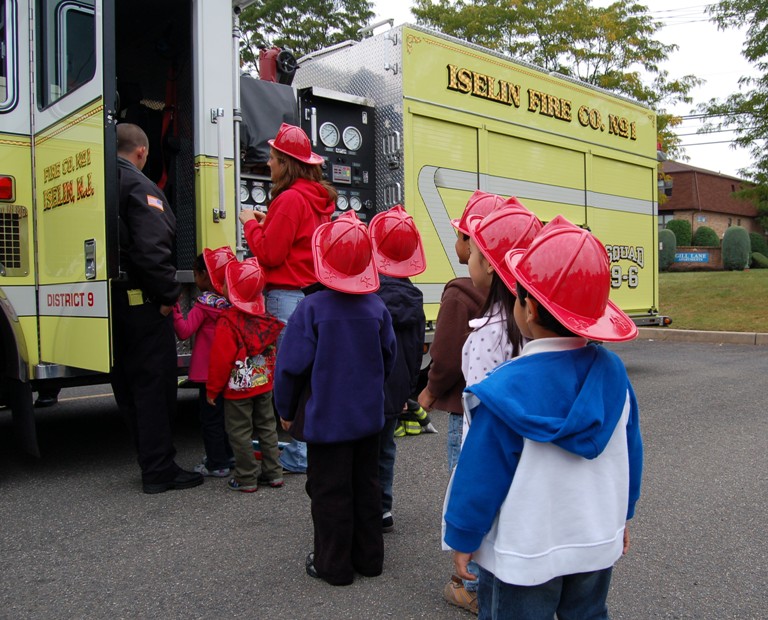
The Bureau of Fire Prevention visits all schools and day care centers at least once per year to speak to the children and staff about fire safety. A popular activity for the children is get to see the fire trucks up close and personal!
Visits to the Firehouse
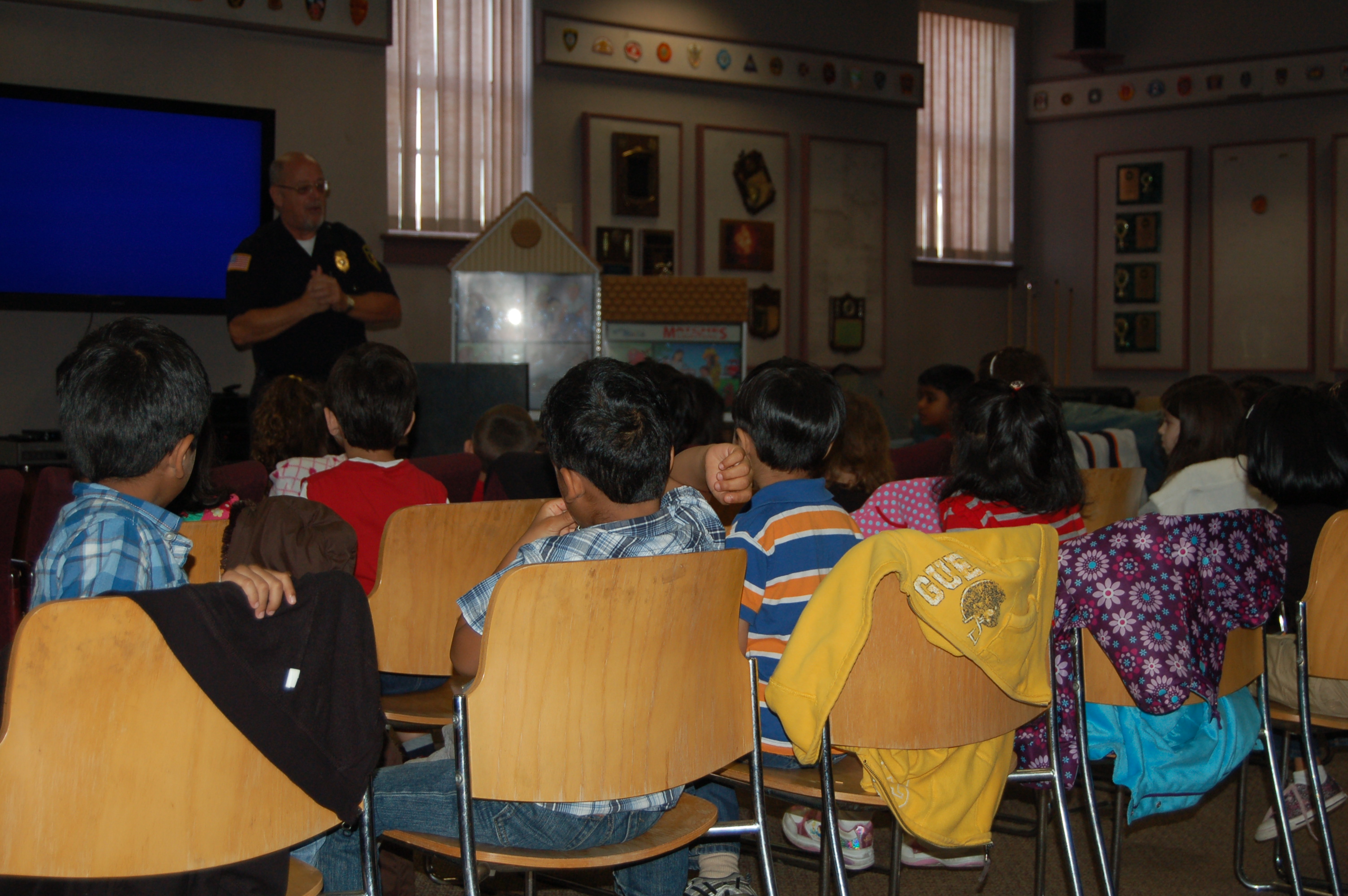
Each year, day care centers, elementary schools (Kindergarten through 3rd grade), scouting groups, and other organizations visit the firehouse for a formal fire safety presentation on topics such as smoke alarms, stop, drop, and roll, and exit drills in the home.
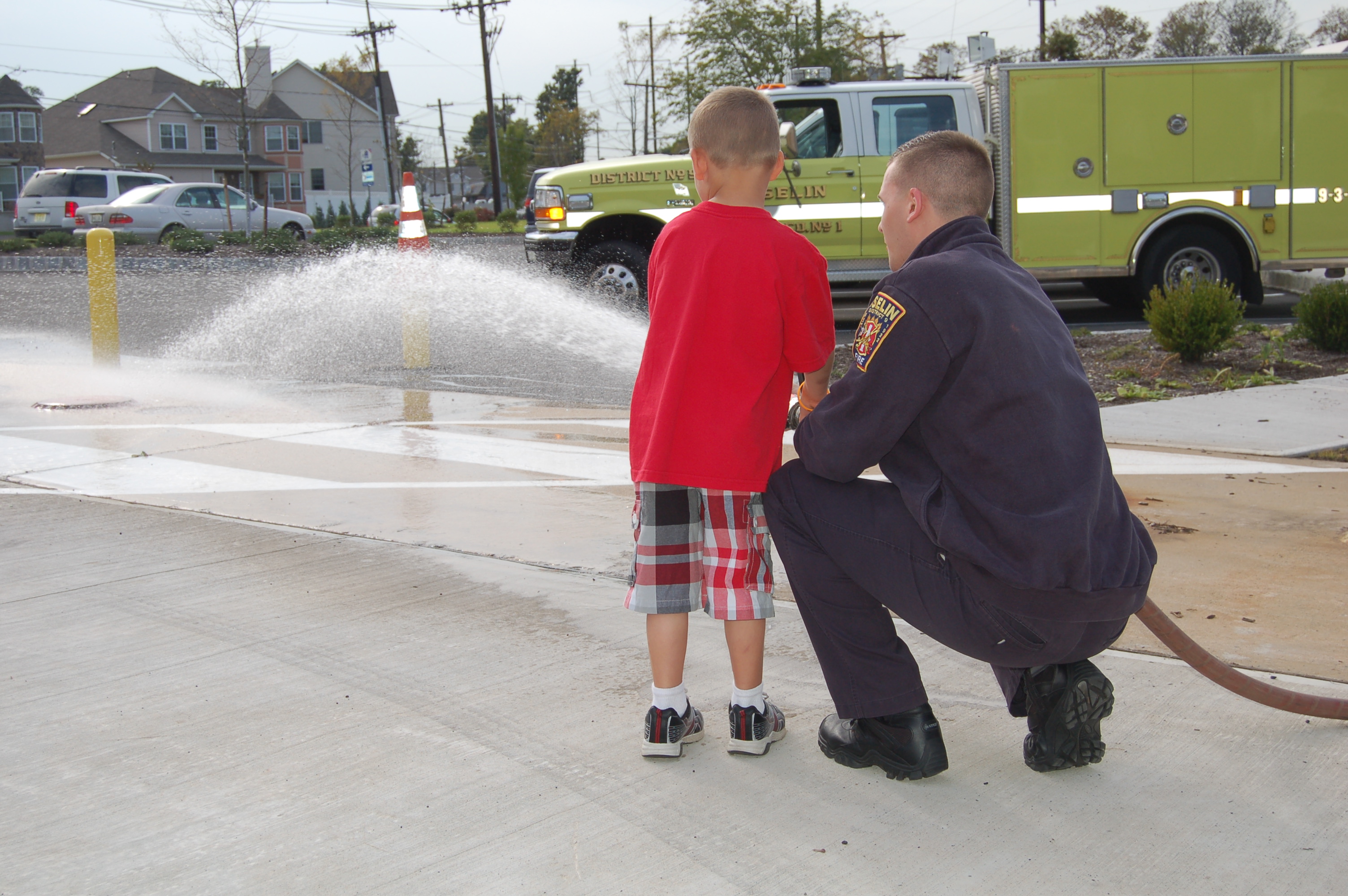
Once the classroom session has been completed, the group gets to see our some of the equipment used by the firefighters as well as the fire apparatus. Also, the children get an opportunity to shoot water from a fire hose.
Open House
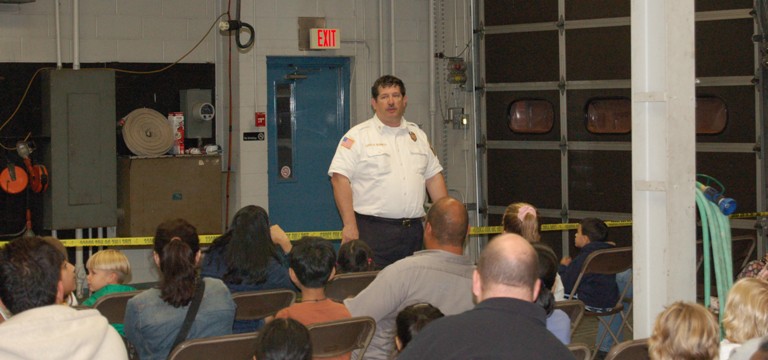
Open Houses are conducted at both firehouses each year during Fire Prevention Week. This is another opportunity to provide fire safety information to both adults and children. Adults learn about fire and carbon monoxide alarms, cooking safety, and the importance of conducting exit drills in the home. The children learn about how to respond if the fire alarm goes off, such as staying low to the floor, checking doors for heat before opening them, and going to a pre-designated family meeting point once outside the home. The highlight of this activity is for the children to actually practice evacuating a bedroom that is filled with non-toxic theatrical smoke using our Fire Safety Trailer. Firefighting equipment and fire apparatus are also on display.
Fire Safety Trailer
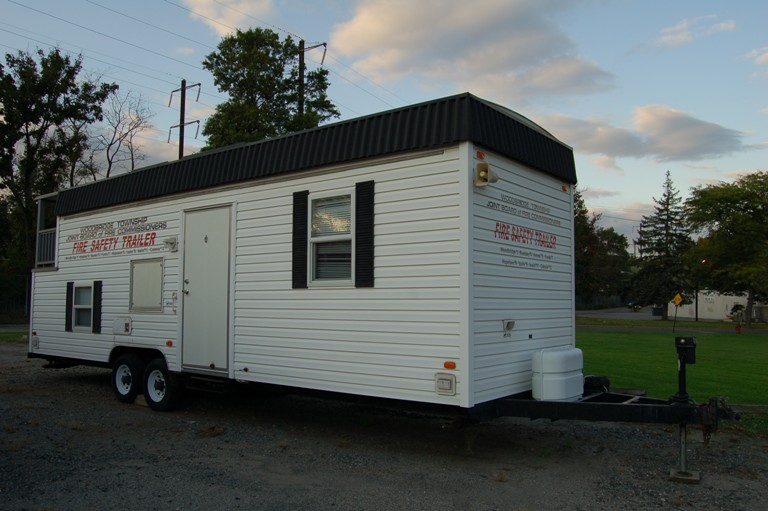
The Woodbridge Township Joint Board of Fire Commissioners has purchased this Fire Safety Trailer. The thirty five foot trailer includes a kitchen, bedroom, and media center. It is designed to train both adults and children about fire safety in the home, with a focus on cooking safety, smoke alarms, calling 9-1-1, and exit drills in the home.
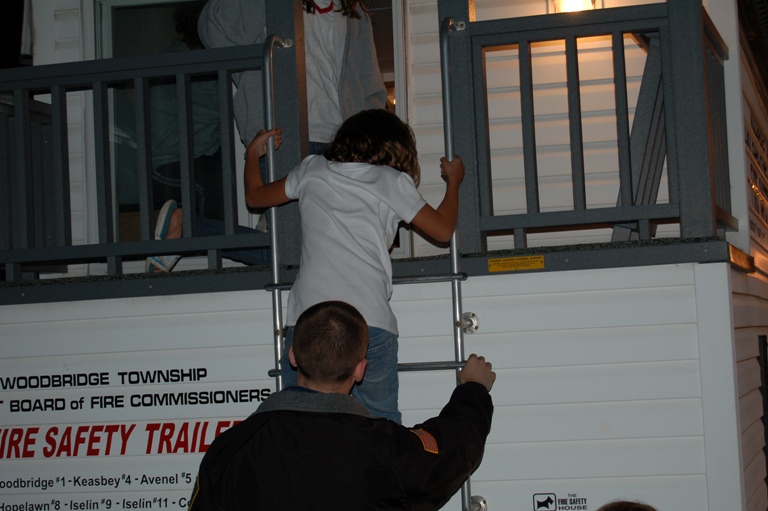
The most popular feature of the trailer is a bedroom located on the second level which has a door which heats up and a system to pump non-toxic theatrical smoke into the room. When the children discover the door is warm to the touch, they exit the trailer through a window and down a ladder. This is used to teach children how to safety exit their bedroom in the event of a fire.
Freddy the Fire Truck
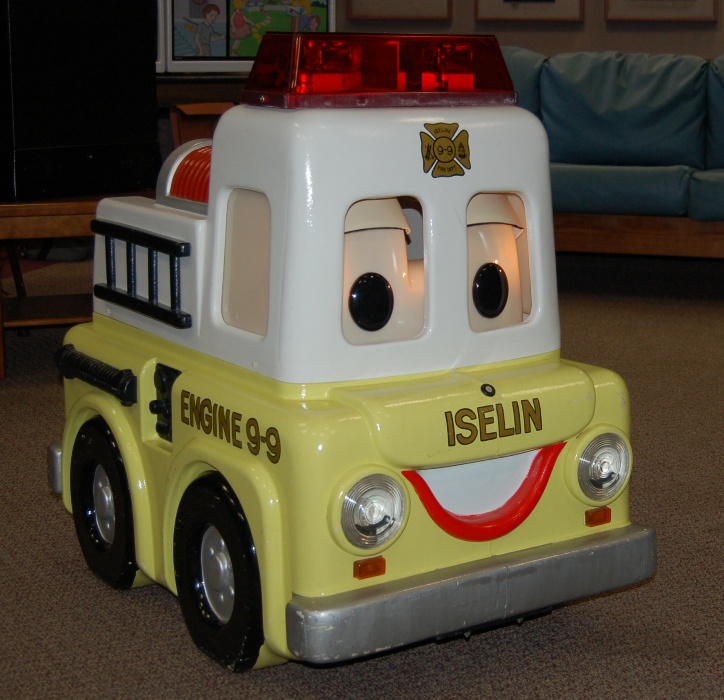
Freddy is our robotic fire truck that is used to help spread the fire safety message to young children.
Fire Inspections
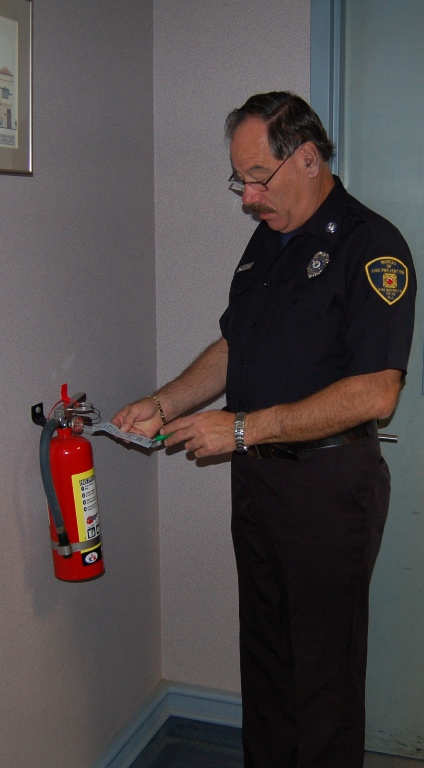
The Bureau of Fire Prevention has responsibility for conducting fire safety inspections and enforcing the provisions of the New Jersey Fire Code and Woodbridge Township Ordinances.
Fire Investigation
The Bureau of Fire Prevention is charged with investigating all fires which occur within the fire district to determine cause and origin.
Fire Safety Information

Residential hazardous materials (hazmat) safety is important in preventing fires in and around your home. Hazmat safety involves the proper handling and storage of combustibles and flammable liquids such as gasoline, kerosene, propane, oil, aerosols, certain household cleaning products, and painting supplies.
The following are some safety tips you can follow to avoid a hazmat emergency:
- Use proper storage containers for flammables and combustibles;
- Know how to shut off the gas supply in case of an emergency;
- Never store flammables in direct sunlight or near an open flame;
- Inspect storage areas regularly and be on the lookout for leaky containers, poor ventilation, and the smell of fumes; and
- Store hazardous materials out of the reach of children and pets.
Learn More »

Decorating homes and businesses is a long-standing tradition around the holiday season. Unfortunately, these same decorations may increase your chances of fire.
Based on data from the U.S. Fire Administration (USFA) and the National Fire Protection Association (NFPA), an estimated 250 home fires involving Christmas trees, and another 170 home fires involving holiday lights, and other decorative lighting occur each year. Together, these fires resulted in 20 deaths and 45 injuries.
Following a few simple fire safety tips can keep electric lights, candles, and the ever popular Christmas tree from creating a tragedy. Learn how to prevent a fire and what to do in case a fire starts in your home. Make sure all exits are accessible and not blocked by decorations or trees. Help ensure that you have a fire safe holiday season.
Holiday Decorations
Decorating for the winter holidays is fun but can lead to tragedy if you don't practice fire safety. Following a few simple fire safety tips can keep electric lights, candles, and the ever popular Christmas tree from creating a tragedy.
- Don't place your live Christmas tree close to a heat source, including a fireplace or heat vent.
- Keep the tree stand filled with water at all times.
- Never put tree branches or needles in a fireplace or wood-burning stove.
- Inspect holiday lights for frayed wires, bare spots, gaps in the insulation, broken or cracked sockets, and excessive kinking or wear before putting them up.
- Use only nonflammable decorations.
Learn More »

Home fires are more prevalent in winter than in any other season. This is due in part to an increase in cooking and heating fires. Holiday decorations and winter storms that can interrupt electrical service and cause people to turn to alternative heating sources also contribute to the increased risk of fire in winter. Winter fires can be prevented!
Each winter the high cost of home heating fuels and utilities causes many Americans to search for alternate sources of home heating. The use of wood burning stoves is growing and space heaters are selling rapidly. Fireplaces are burning wood and man-made logs. All these methods of heating may be acceptable. They are however, a major contributing factor in home fires.
Many of these fires can be prevented. You can prevent the loss of life and property resulting from heating fires by being able to identify potential hazards and following a few safety tips:
- All heaters need space. Keep anything that can burn at least 3 feet away from heating equipment.
- Use heating equipment that has the label of a recognized testing laboratory.
- Make sure all fuel-burning heating equipment is vented to the outside to avoid carbon monoxide (CO) poisoning.
- Only purchase portable space heaters with an automatic shut-off so if they’re tipped over they will shut off.
- Allow wood stove and fireplace ashes to cool before disposing of them in a tightly covered metal container. Keep the container at least 10 feet away from your home.
Electrical Fire Safety
Electrical fires in our homes claim the lives of 280 Americans each year. Many of these fires are caused by incorrectly installed wiring and overloaded circuits and extension cords.
Winter fires can be prevented! The following electrical fire safety tips can help you maintain a fire-safe home this winter season.
- Routinely check your electrical appliances and wiring.
- Frayed wires can cause fires. Replace all worn, old or damaged appliance cords immediately.
- Replace any electrical tool if it causes even small electrical shocks, overheats, shorts out, or gives off smoke or sparks.
- Keep electrical appliances away from wet floors and counters; pay special care to electrical appliances in the bathroom and kitchen.
- Buy electrical products evaluated by a nationally recognized laboratory, like UL.
- Keep clothes, curtains, and other potentially combustible items at least three feet from all heaters.
- If an appliance has a three-prong plug, use it only in a three-slot outlet. Never force it to fit into a two-slot outlet or extension cord.
- Don't allow children to play with or around electrical appliances like space heaters, irons, and hair dryers.
- Use safety closures to "child-proof" electrical outlets.
- Use electrical extension cords wisely; never overload extension cords or wall sockets.
- Immediately shut off, then professionally replace, light switches that are hot to the touch and lights that flicker.
Winter Storm Fire Safety
Alternative heating devices, downed power lines, portable generators, and damaged appliance are all potential hazards during and after a winter storm.
We encourage you to use the following safety tips to help protect yourself, your family, and your home from the potential threat of fire during or after a winter storm.
* Alternative heaters need their space. Keep anything that can burn at least 3 feet away.
* Never refuel a heater while it is in operation or still hot.
* If there is a fire hydrant near your home, keep it clear of snow and debris for easy access by the fire department.
* Always use a flashlight - not a candle - for emergency lighting.
* Do not use the kitchen oven or range to heat your home. In addition to being a fire hazard, it can be a source of toxic fumes.
More Winter Storm Fire Safety Action Steps »
Smoking Fire Safety
It may be cold in much of the United States right now, but if you smoke, it’s better to smoke outside. A lit cigarette left alone in a room, or accidentally dropped onto a chair or bed, or hot cigarette ashes or matches tossed away before they are completely out - all can cause a large fire in seconds.
Putting out a cigarette the right way only takes seconds, too. It is up to you to make sure your cigarette is put out, all the way, every time.
One-in-four people killed in home fires is not the smoker whose cigarette caused the fire.
- More than one-third were children of the smokers.
- Twenty-five percent were neighbors or friends of the smokers.
Take a moment to learn about Smoking and Home Fire action steps »
Winter Safety Spotlight: Carbon Monoxide
Each year in America, more than 150 people die from accidental non-fire related CO poisoning associated with consumer products. These products include faulty, improperly-used or incorrectly-vented fuel-burning appliances such as furnaces, stoves, water heaters and fireplaces.
The U.S. Fire Administration would like you to know that there are simple steps you can take to protect yourself from deadly carbon monoxide fumes. Please read and follow the safety tips contained in the link below.
Carbon Monoxide Safety Action Steps »

With the holidays fast approaching and the increased usage of seasonal decorations, it is important to focus on candle fire safety and prevention. Because the majority of candle fires result from human error and negligence, candle fires and their associated casualties are preventable.
- If possible, avoid using lighted candles.
- If you must use candles, ensure that they are placed in sturdy holders.
- Keep candles away from children and pets.
- Be sure to extinguish candles after each use.
- Never leave burning candles unattended.
By following a few candle fire safety tips, everyone can enjoy a safe and happy holiday season.
Causes and Circumstances of Home Candle Fires
- On average, 42 home candle fires are reported every day.
- More than half of all candle fires start when something that could burn, such as furniture, mattresses or bedding, curtains, or decorations is too close to the candle.
- In one-fifth (20%) of candle fires, the candles are unattended or abandoned.
- Over one-third (36%) of home candle fires begin in the bedroom.
- Falling asleep is a factor in 12% of home candle fires and 36% of the associated deaths.
- December is the peak time of year for home candle fires. In December, 13% of home candle fires begin with decorations compared to 4% the rest of the year.
- One-half of home candle fire deaths occur between Midnight and 6 am.
- Young children and older adults have the highest death risk from candle fires.
- The risk of fatal candle fires appears higher when candles are used for light.
Candle Safety Tips
Put candles in sturdy metal, glass, or ceramic holders.
- Avoid using lighted candles.
- If you do use candles, ensure they are in sturdy metal, glass or ceramic holders and placed where they cannot be easily knocked down.
- Keep candles out of the reach of children and pets.
- Set a good example by using matches, lighters, and fire carefully.
- Children should never be allowed to play with matches, lighters, or candles.
- Never put candles on a Christmas tree.
- Extinguish candles after use and before going to bed.
- And NEVER leave burning candles unattended

Did you know that 50 percent of child fire deaths affect those under the age of 5? Escaping from a fire can be difficult for very young children because they generally lack the motor skills and mental capabilities needed to quickly escape a burning building. The U.S. Fire Administration provides fire prevention information to teach children and their caregivers about the dangers of fire. Protect your kids: install and maintain smoke alarms and residential sprinklers and practice home fire escape plans to ensure your children will be safe if a fire were to start in your home.
Children and Fire: Life Saving Tips
Young children are not able to sense danger in the same way as adults. They have a very limited ability to react quickly and properly in an emergency situation as well as little control over their environment. This increases their risk of death and injury in a fire.
- Keep matches, lighters and other items used for ignition in a secured drawer or cabinet out of the reach of children.
- Teach your children to tell you when they find matches and lighters.
- Always dress children in pajamas that meet Federal flammability standards. Avoid dressing children for sleep in loose-fitting, 100% cotton garments, such as oversized t-shirts.
- Teach children not to hide from firefighters, but to get out quickly and call for help from another location.
- Show children how to crawl low on the floor, below the smoke, to get out of the house and stay out.
- Demonstrate how to stop, drop to the ground, and roll if clothes catch fire.
- Develop and practice a home fire escape plan and designate a meeting place outside. Get out and stay out.
- Familiarize children with the sound of your smoke alarm.
- Replace mattresses made prior to the 2007 Federal Mattress Flammability Standard.
- Check under beds and in closets for burnt matches, evidence your child may be playing with fire.

Every year, approximately 2,600 Americans die in home fires. Over half of these deaths (52%) occur between the hours of 10:00pm and 7:00am, when residents are typically sleeping. Smoke and toxic gases from a home fire are as deadly as heat and flames. Just two or three breaths of toxic smoke can render you unconscious. The majority of fire victims die or are injured from exposure to smoke and toxic gases, such as carbon monoxide, not actual burns. In addition, smoke obscures vision, decreasing your ability to escape.
Smoke alarms save lives, prevent injuries, and minimize property damage by detecting fires early and alerting residents, allowing crucial time to escape. The risk of dying from a fire in a home without working smoke alarms is twice as high as in a home that has working smoke alarms.
What types of smoke alarms are available?
There are many different brands of smoke alarms available on the market but they fall under two basic types: ionization and photoelectric.
- Ionization alarms sound more quickly when a flaming, fast moving fire occurs.
- Photoelectric alarms are quicker at sensing smoldering, smoky fires.
- There are also combination (dual sensor) smoke alarms that combine ionization and photoelectric into one unit.
Because both ionization and photoelectric smoke alarms are better at detecting distinctly different yet potentially fatal fires, and because home residents cannot predict what type of fire might start in a home, the U.S. Fire Administration recommends the installation of both ionization and photoelectric or dual sensor smoke alarms.
In addition to the basic types of smoke alarms, there are alarms made to meet the needs of people with hearing disabilities. These alarms may use strobe lights that flash and/or vibrate to assist in alerting those who are unable to hear standard smoke alarms when they sound.
How long will my smoke alarm last?
Most alarms installed today have a life span of about 8-10 years. After this time, the entire unit should be replaced. It is a good idea to write the date of purchase with a marker on the inside of your alarm so you will know when to replace it. Always follow the manufacturer’s instructions for replacement.

Grills, Fire Pits, and Campfires
Every year Americans look forward to summer vacations, camping, family reunions, picnics, and the Fourth of July. Summertime, however, also brings fires and injuries due to outdoor cooking and recreational fires. Annually, there are almost 3,800 Americans injured by gas or charcoal grill fires. (Source: CPSC)
Summertime should be a time of fun and making happy memories. Knowing a few fire safety tips and following safety instructions will help everyone have a safe summer.
Residential Grill Fire Facts
- An estimated 5,700 grill fires occur on residential properties each year in the United States.
- Almost half (49 percent) of grill fires on residential properties occur from 5 to 8 p.m.
- Over half (57 percent) of grill fires on residential properties occur in the 4 months of May, June, July, and August.
- Thirty-two percent of grill fires on residential properties start on patios, terraces, screened-in porches, or courtyards.
Grill Safety
- Propane and charcoal BBQ grills must only be used outdoors. If used indoors, or in any enclosed spaces such as tents, they pose both a fire hazard and the risk of exposing occupants to toxic gases and potential asphyxiation.
- Position the grill well away from siding, deck railing, and out from under eaves and overhanging branches.
- Place the grill a safe distance from lawn games, play areas, and foot traffic.
- Keep children and pets from the grill area: declare a three-foot "safe zone" around the grill.
- Put out several long-handled grilling tools to give the chef plenty of clearance from heat and flames when cooking.
- Periodically remove grease or fat buildup in trays below the grill so it cannot be ignited by a hot grill.
Charcoal Grills
- Purchase the proper starter fluid and store out of reach of children and away from heat sources.
- Never add charcoal starter fluid when coals or kindling have already been ignited, and never use any flammable or combustible liquid other than charcoal starter fluid to get the fire going.
Propane Grills
- Check the propane cylinder hose for leaks before using it for the first time each year. A light soap and water solution applied to the hose will reveal escaping propane quickly by releasing bubbles.
- If you determined your grill has a gas leak by smell or the soapy bubble test and there is no flame:
- Turn off the propane tank and grill.
- If the leak stops, get the grill serviced by a professional before using it again.
- If the leak does not stop, call the fire department.
- If you smell gas while cooking, immediately get away from the grill and call the fire department. Do not attempt to move the grill.
- All propane cylinders manufactured after April 2002 must have overfill protection devices (OPD). OPDs shut off the flow of propane before capacity is reached, limiting the potential for release of propane gas if the cylinder heats up. OPDs are easily identified by their triangular-shaped hand wheel.
- Use only equipment bearing the mark of an independent testing laboratory. Follow the manufacturers' instructions on how to set up the grill and maintain it.
- Never store propane cylinders in buildings or garages. If you store a gas grill inside during the winter, disconnect the cylinder and leave it outside.
First Aid for Burns
For minor burns, take the following action:
- Cool the burn. Hold the burned area under cool (not cold) running water for 10 or 15 minutes or until the pain subsides. If this is impractical, immerse the burn in cool water or cool it with cold compresses. Cooling the burn reduces swelling by conducting heat away from the skin. Don't put ice on the burn.
- Cover the burn with a sterile gauze bandage. Don't use fluffy cotton, or other material that may get lint in the wound. Wrap the gauze loosely to avoid putting pressure on burned skin. Bandaging keeps air off the burn reduces pain and protects blistered skin.
- Take an over-the-counter pain reliever. These include aspirin, ibuprofen, naproxen or acetaminophen. Use caution when giving aspirin to children or teenagers. Though aspirin is approved for use in children older than 2, children and teenagers recovering from chickenpox or flu-like symptoms should never take aspirin.
Talk to a doctor if you have concerns.
Source: Mayo Clinic
Fire Pits
In recent years, there has been a new concern for the Fire Service - fire pits. Fire pits are known to be a great source of warmth and ambience. But, with the popularity of fire pits increasing, fire safety has become even more important. There are many things you should consider while setting up and using a fire pit.
- Keep away from flammable material and fluids such as gasoline, diesel fuel, kerosene, and charcoal lighter fluid or vehicles while in use.
- Do not use flammable fluids such as gasoline, alcohol, diesel fuel, kerosene, and charcoal lighter fluid to light or relight fires.
- Exercise the same precautions you would with an open fire.
- Do not allow children to use the fire pit. Keep children and pets away.
- Do not wear flammable or loose fitting clothing such as nylon.
- Do not burn trash, leaves, paper, cardboard, or plywood. Avoid using soft wood such as pine or cedar that likely pop and throw sparks. Use of seasoned hardwood is suggested.
- Before starting the fire, make sure that the lid will still close to extinguish the fire in case of emergency. Do not overload.
- Before you light the fire, check the wind direction.
- Keep a fire extinguisher or garden hose nearby.
Source: Fire Pits Helper
Campfires
When building a camp fire, follow these campfire safety tips from Smokey Bear:
How to Pick Your Spot
- DO NOT build a fire at a site in hazardous, dry conditions. DO NOT build a fire if the campground, area, or event rules prohibit campfires.
- FIND OUT if the campground has an existing fire ring or fire pit.
- If there is not an existing fire pit, and pits are allowed, look for a site that is at least fifteen feet away from tent walls, shrubs, trees or other flammable objects. Also beware of low-hanging branches overhead.
Extinguishing Your Campfire
When you're ready to put out your fire and call it a night, follow these guidelines:
- Allow the wood to burn completely to ash, if possible.
- Pour lots of water on the fire; drown all embers, not just the red ones.
- Pour until hissing sound stops.
- Stir the campfire ashes and embers with a shovel.
- Scrape the sticks and logs to remove any embers.
- Stir and make sure everything is wet and they are cold to the touch.
- If you do not have water, use dirt. Mix enough dirt or sand with the embers. Continue adding and stirring until all material is cool. REMEMBER: do NOT bury the fire as the fire will continue to smolder and could catch roots on fire that will eventually get to the surface and start a wildfire.
REMEMBER: If it is too hot to touch, it's too hot to leave!

Cooking fires continue to be the most common type of fires experienced by U.S. households. This is even more apparent during the holidays. There is an increased incidence of cooking fires on Thanksgiving, Christmas Eve Day, and Christmas Day. Cooking fires are also the leading cause of civilian fire injuries in residences. These fires are preventable by simply being more attentive to the use of cooking materials and equipment.
Don’t become a cooking fire casualty. Learn the facts about cooking fire safety today!
Safe Cooking Tips
The kitchen can be one of the most hazardous rooms in the home if you don’t practice safe cooking behaviors. Here are some safety tips to help:
- Stay in the kitchen when you are frying, grilling, or broiling food. If you leave the kitchen for even a short period of time, turn off the stove.
- If you are simmering, baking, roasting, or boiling food, check it regularly, remain in the home while food is cooking, and use a timer to remind you that you're cooking.
- Stay alert! To prevent cooking fires, you have to be alert. You won't be if you are sleepy, have been drinking alcohol, or have taken medicine that makes you drowsy.
- Keep anything that can catch fire - potholders, oven mitts, wooden utensils, paper or plastic bags, food packaging, towels, or curtains - away from your stovetop.
- Keep the stovetop, burners, and oven clean.
- Wear short, close-fitting or tightly rolled sleeves when cooking. Loose clothing can dangle onto stove burners and catch fire if it comes into contact with a gas flame or electric burner.
- Plug microwave ovens and other cooking appliances directly into an outlet. Never use an extension cord for a cooking appliance, as it can overload the circuit and cause a fire.
When cooking, stay in the kitchen and keep an eye on the stove.
If You Have a Cooking Fire
- When in doubt, just get out. When you leave, close the door behind you to help contain the fire. Call 9-1-1 or the local emergency number after you leave.
- If you do try to fight the fire, be sure others are already getting out and you have a clear path to the exit.
- Always keep an oven mitt and a lid nearby when you are cooking. If a small grease fire starts in a pan, smother the flames by carefully sliding the lid over the pan (make sure you are wearing the oven mitt). Turn off the burner. Do not move the pan. To keep the fire from restarting, leave the lid on until the pan is completely cool.
- In case of an oven fire, turn off the heat and keep the door closed to prevent flames from burning you or your clothing.
- If you have a fire in your microwave oven, turn it off immediately and keep the door closed. Never open the door until the fire is completely out. Unplug the appliance if you can safely reach the outlet.
- After a fire, both ovens and microwaves should be checked and/or serviced before being used again.
Nuisance Smoke Alarms
If a smoke alarm sounds during normal cooking, you may need to move it farther away from the kitchen (according to manufacturer’s instructions) and/or install a smoke alarm with a pause button.
If your alarm already has a pause button, push the pause button, open the door or window, and fan the area around the alarm with a towel to get the air moving. Do not disable the smoke alarm or take the batteries out!
Treat every smoke alarm activation as a likely fire and react quickly and safely to the alarm.
Turkey Fryer Safety Tips
- Use turkey fryers outdoors a safe distance from buildings and any other combustible materials.
- Never use turkey fryers in a garage or on a wooden deck.
- Make sure fryers are used on a flat surface to reduce accidental tipping.
- Never leave the fryer unattended. Most units do not have thermostat controls. If you do not watch the fryer carefully, the oil will continue to heat until it catches fire.
- Never let children or pets near the fryer even if it is not in use. The oil inside the cooking pot can remain dangerously hot hours after use.
- To avoid oil spillover, do not overfill the fryer.
- Use well-insulated potholders or oven mitts when touching pot or lid handles. If possible, wear safety goggles to protect your eyes from oil splatter.
- Make sure the turkey is completely thawed and be careful with marinades. Oil and water do not mix; water causes oil to spill over causing a fire or even an explosion hazard.
- The National Turkey Federation recommends thawing the turkey in the refrigerator approximately 24 hours for every five pounds in weight.
- Keep an all-purpose fire extinguisher nearby. Never use water to extinguish a grease fire. If the fire is manageable, use your all-purpose fire extinguisher. If the fire increases, immediately call the fire department for help.
Source: Underwriters Laboratories

Young children are at high risk from non-fire cooking-related burns. Have a “kid-free zone” of at least 3 feet around the stove.
Burns and Scalds
Most burns associated with cooking equipment, cookware, and tableware are not caused by fire or flame. In 2009, ranges or ovens were involved in an estimated 17,300 thermal burn injuries seen in U.S. hospital emergency rooms. (Source: NFPA) Microwaves are a leading cause of scald burns. Be extra careful when opening a heated food container. Heat food in containers that are marked ‘microwave safe.’ Since foods heat unevenly in the microwave, make sure you stir and test the food before eating.
Protecting Children from Scalds and Burns
Children under five face a higher risk of non-fire burns associated with cooking than of being burned in a cooking fire. (Source: NFPA) You can help prevent these injuries by following a few basic tips:
- Keep children at least 3 feet away from where food and drink are being prepared or carried.
- Keep hot foods and liquids away from the table or counter edges.
- Use the stove’s back burners if you have young children in the home.
- Never hold a child while cooking, drinking, or carrying hot foods or liquids.
Also, teach children that hot things burn!

An estimated 900 portable heater fires in homes are reported to U.S. fire departments each year, and cause an estimated 70 deaths, 150 injuries, and $53 million in property loss.
Only two percent of heating fires in homes involve portable heaters; however, portable heaters are involved in over 45 percent of all fatal heating fires in homes.
You can prevent a portable heater fire in your home this winter by following a few fire saftey tips:
* Turn heaters off when you go to bed or leave the room.
* Keep anything that can burn such as bedding, curtains, and clothing at least 3 feet away.
* Only use portable heaters from a recognized testing laboratory and with an automatic shutoff so that if they tip over, they shut off.
* Plug portable heaters directly into outlets and never into an extension cord or power strip.
Learn more about portable heaters and fire safety at www.usfa.fema.gov/heating.
Fire Prevention, Preparedness & Recovery for Families and Pets
https://www.yourlawyer.com/library/fire-prevention-for-families-and-pets/
|


